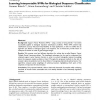Free Online Productivity Tools
i2Speak
i2Symbol
i2OCR
iTex2Img
iWeb2Print
iWeb2Shot
i2Type
iPdf2Split
iPdf2Merge
i2Bopomofo
i2Arabic
i2Style
i2Image
i2PDF
iLatex2Rtf
Sci2ools
RECOMB
2005
Springer
2005
Springer
Learning Interpretable SVMs for Biological Sequence Classification
Background: Support Vector Machines (SVMs) ? using a variety of string kernels ? have been successfully applied to biological sequence classification problems. While SVMs achieve high classification accuracy they lack interpretability. In many applications, it does not suffice that an algorithm just detects a biological signal in the sequence, but it should also provide means to interpret its solution in order to gain biological insight. Results: We propose novel and efficient algorithms for solving the so-called Support Vector Multiple Kernel Learning problem. The developed techniques can be used to understand the obtained support vector decision function in order to extract biologically relevant knowledge about the sequence analysis problem at hand. We apply the proposed methods to the task of acceptor splice site prediction and to the problem of recognizing alternatively spliced exons. Our algorithms compute sparse weightings of substring locations, highlighting which parts of the ...
Computational Biology | Position Weight Matrices | RECOMB 2005 | Support Vector | Support Vector Machines |
| Added | 03 Dec 2009 |
| Updated | 03 Dec 2009 |
| Type | Conference |
| Year | 2005 |
| Where | RECOMB |
| Authors | Christin Schäfer, Gunnar Rätsch, Sören Sonnenburg |
Comments (0)

